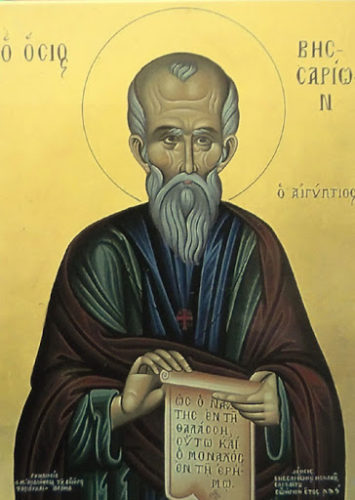
Abba Bessarion the Wonderworker
From Trisagion Films

Father George Bithos' weblog

Abba Bessarion the Wonderworker
From Trisagion Films
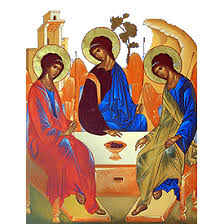
Have you ever considered the possibility that your idea of God is too small? What do you think about when you hear the word “GOD”? Maybe, it would help if we consider some of the Church’s teachings about God. First, let’s ask the basic question Who is God?” There are certain fundamental Orthodox teachings on this question. When we try to define God, we come to Mystery. Beginning with that question: What is God? The Church says “GOD IS” – He is beyond all human understanding, language, and abilities to grasp or describe.
God is Love; whoever sought to define Him would be like a blind person trying to count the grains of sand of the sea shore. – St. John Climakos
God is a God, who out of Love, reveals Himself to his creatures and creation. Our God is a Personal God, that is why the question is WHO is GOD and not WHAT is God. Our God is a TRINITARIAN GOD. What does this mean? The nature of God as Trinity is explained St. Basil in this way:
The Father is the origin of all, the Son realizes, and the Spirit fulfills. Every thing subsists by the will of the Father, comes into being though the action of the Son, and reaches its perfection through the action of the Holy Spirit…The number three therefore comes to your mind: the Lord who commands, The Word who creates, the Breath who confirms and what can it mean to confirm, if not to make perfect in holiness.
Treatise on the Holy Spirit – ST BASIL OF CAESARIA.
Think about the description of the nature of God, as we can understand him. Keep in mind; we can never understand the essence of God. Yet, all Three Persons of the Holy Trinity share the same essence (Nicene-Constantinopolitan Creed). They are unique persons; they are distinct but never separate. They have but one will, the will of the Father. NONE of three ever acts separately and apart from the other two. Metropolitan Kallistos Ware states, “They are not three Gods but one God.” What is it about God that we experience and know? We Orthodox view what and how we experience the Trinity in this way.
God is love (1 John, 8). The Persons of the Holy Trinity relate to one and another in a bond of LOVE, a perfect outpouring of selfless communion that is continuous, constant and mysterious. This is the nature of the relationship of the life of God as Trinity. Our destiny is to share this love and to express it in our lives. When we talk about God, we mean the Holy Trinity; and when we will speak of Christ, the second person of the Trinity, we speak of the Son of God revealed and encountered in the created world. In Christ, empowered by God’s Holy Spirit and through our Baptism and Chrismation, we have the potential to partake in the nature of God as Trinity (2 Peter 1, 3).
For Orthodox, the true image of God and the true nature of man are revealed in history by one event. God has revealed Himself to us in Christ. Through the Holy Spirit and the Virgin Mary, the Theotokos,. Christ accomplishes this by His Incarnation in the Flesh. The Incarnation of our Savior, the Lord Jesus Christ, reveals the image of the Father to the world and only through Him, in the Holy Spirit, can we KNOW God the Father (St. John 17, 25-26). The hymn of Christmas, by St. Romanos the Melodist, summarizes the theology of incarnation with this phrase, “A new born child; God before the Ages”.
The Incarnation is an act of GOD out of love. It is an act of God identifying with our nature and of sharing His Nature with us. The nature of God as Trinity was the topic of the first two Ecumenical Councils; the next five great Councils dealt with who is Jesus and what is His relationship to us, His creation.
Earlier we said, the Godhead is a perfect community of love shared between the THREE Persons of the Trinity. The Incarnation is also about sharing and participation. Christ shares our humanity, even to death on the cross. This act of perfect Love enables us, in Christ, through His Spirit to participate in the life of God. We are called to intimate communion, even friendship with our Lord. The entire history of Christ in the world can be summed up in one word ENCOUNTER. Through Him, in Him and with Him, we encounter the Living God. Christ assumed our human nature and our human body. He transformed them with the Glory of God and showed us the true original beauty of our created potential. He presents it to His Father, wholly transfigured, so that we might share in the Nature of God.
This is the reason why the Word of God was made flesh, and the Son of God became the Son of Man: so that we could enter into communion with the Word of God and by receiving adoption might become the Sons of God. Indeed, we should not be able to share in immortality without a close union with the Immortal.
St. Ireneaus of Lyons
In Christ, we are called to KNOW the Father. This knowledge is the prayer of Christ before his crucifixion. His Resurrection abolished the hold which death had on us since our fall. His Accession granted us an intercessor at the Throne of God. At Pentecost, He asks the Father to send His Spirit to continue His Presence among us. His Second Coming will give the righteous immortality and perfect communion with God. These words of prayer explain our relationship to God the Holy Trinity.
My hope is the Father,
My refuge is the Son.
My Protection is the Holy Spirit,
O Holy Trinity – Glory to You.
St. Ioannikios the Great
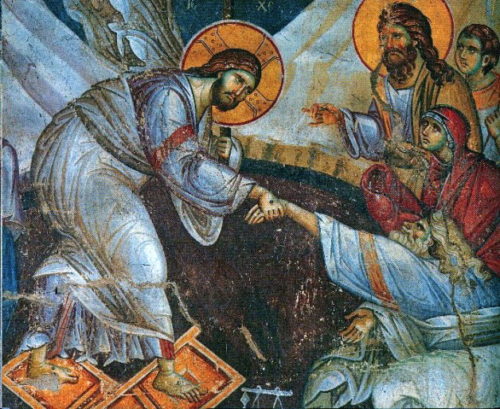
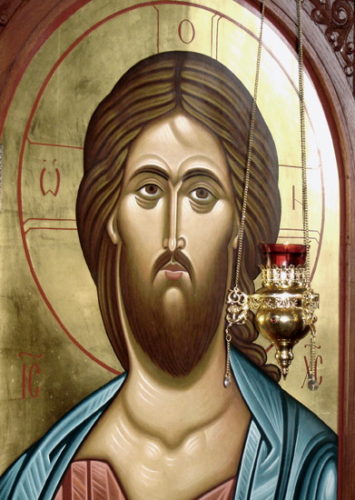
In our Lenten Journey we are called upon to look to three foundational guideposts. These are Prayer, Fasting and Alms Giving. As we approach the mid-point in Great Lent, I offer this small prayer to assist you.
A prayer from St. John Chrysostom according to the Hours of the Day or Night
1:00 AM: Lord, deprive me not of Your heavenly and eternal blessings.
2:00 AM: Lord, deliver me from everlasting torments.
3:00 AM: Lord, if I have sinned in word or deed, in mind, or spirit, forgive me.
4:00 AM: Lord, deliver me from all distress, ignorance, forgetfulness, laziness, and stony hardness of heart.
5:00 AM: Lord, deliver me from all temptations and spiritual abandonment.
6:00 AM: Lord, enlighten my heart which has been darkened by evil desire.
7:00 AM: Lord, being human, I sin; but You, being God, have mercy on me.
8:00 AM: Lord, take heed of the weakness of my soul, and help me with Your grace that Your holy name may be glorified in me.
9:00 AM: Lord Jesus Christ, inscribe the name of Your servant in the book of life, granting me a blessed end.
10:00 AM: Lord my God, I have done nothing good; yet by Your compassion help me to make a new beginning.
11:00 AM: Lord, refresh my heart with the dew of Your grace.
12:00 PM: Lord, God of heaven and earth, remember me, who am sinful, wretched, evil and impure, in Your kingdom, according to Your steadfast love.
1 :00 PM: Lord, receive me in repentance and do not forsake me.
2:00 PM: Lord, put me not to the test.
3:00 PM: Lord, grant me good thoughts.
4:00 PM: Lord, grant me tears of repentance, remembrance of death and contrition.
5:00 PM: Lord, grant me sincere confession of my thought.
6:00 PM: Lord, grant me humility, deliverance from my own will and obedience.
7:00 PM: Lord, grant me patience, forbearance and meekness.
8:00 PM: Lord, implant in me Your holy fear, the source of all blessings.
9:00 PM: Lord, enable me to love You with all my soul, my mind and my heart; and my neighbor as myself.
10:00 PM: Lord, protect me from evil people and demons, from impure passions and all unseemly things.
11:00 PM: Lord, as you commanded; Lord, as You know all things; Lord, as You desire I desire Your goodness; let Your will be done in me.
12:00 AM: Lord, let Your will, not mine, be done through the intercessions of the all-holy Theotokos and of all the Saints, for You are blessed forever. Amen.
As many of you know, I read for my Ph.D. in England at the University of Durham. During this time I gained a great appreciation for the early Orthodox saints of Great Britain. One of these saints is St. Cuthbert of Lindisfarne, whose holy relics are buried in the Great Cathedral of Durham on the university campus. Last Saturday, our Holy Church commemorated St. Cuthbert.. This short film from Trisagion Films tells his story. I pray you find it inspirational and begin to appreciate the rich heritage of the Celtic saints of the Church. God Bless….Fr. G.

This Sunday our Holy Church turns our attention to the restoration of the holy icons into the Church. We celebrate this event with the commemoration of the Sunday of Orthodoxy. I could say much in discussing this feast and as a matter of fact my entire dissertation studies the details of this event. Nonetheless, I would ask you to think a moment on this questions. What do the faces in this icon or any icon really say to us?
The icon above is the icon of St Methodios l, Patriarch of Constantinople, the Confessor. He can also be seen in the icon of the Sunday of Orthodoxy standing next to the icon within the scene. When I talk to people about icons many times I hear: “but they don’t look like real people.” In making this observation people touch on the very truth of the icon. Even though the image depicts “real people” they are shown in their deified reality. What does this mean? As Orthodox Christians we are all called to struggle ascetically towards our deification in Christ. The saints depicted in the icons are the truth of this endeavor. In their lives, they have ascended the ladder of deification and are shown in their glorified reality. They are no longer of this world, but belong to the reality of God. Their image in the icon reflects this truth. Byzantine icons reflect the world of God and not the world of fallen man. As the viewer of the icon, we should not be drawn to the beauty and form of the world but the radiance of God’s kingdom. The images are stylized to reflect this glory.
In viewing the icon we are given subtle clues to the reality of the saints life. The icon of St. Methodios above was taken from a drawing of his icon from the Vatican Library. The icon was once present in the loge of Hagia Sophia but was destroyed by an earthquake many years ago. The icon shows a white scarf encircling the patriarch’s face. This detail testifies to the suffering of Methodios as a confessor to the faith, in that he was tortured in prison by having his teeth removed and his jaws broken; because of his support of the holy icons. He required this white scarf around his chin for the rest of his life even when he became patriarch. So the icon testifies to his suffering for Christ and his faithfulness to the truth of the Church.
In icons we have the reflection of Christ alive in the life of the person depicted for us in the holy image. Each saint in an icon is truly the reflection of Christ in their life. This is why we place a vigil lamp in front of the icon because the saints depicted there, in the icon, always reflected Christ and His light to their community, in their time and in time in memoriam. So as we see there is more than just a face in the reality of the icons. How very apt is our prayer when we ask the holy saint’s of God to intercede for us!
God Bless and have a Blessed Great Lent……..Fr. G.
![]()
For Orthodox, the true image of God and the true nature of man are revealed in history by one event. God has revealed Himself to us in Christ. Through the Holy Spirit and the Virgin Mary, the Theotokos, Christ accomplishes this by His Incarnation in the Flesh. The Incarnation of our Savior, the Lord Jesus Christ, reveals the image of the Father to the world and only through Him, in the Holy Spirit, can we KNOW God the Father (St. John 17, 25-26). The hymn of Christmas, by St. Romanos the Melodist, summarizes the theology of incarnation with this phrase, “A new born child; God before the Ages”.
The Incarnation is an act of GOD out of love. It is an act of God identifying with our nature and of sharing His Nature with us. The nature of God as Trinity was the topic of the first two Ecumenical Councils; the next five great Councils dealt with who is Jesus and what is His relationship to us, His creation.
Our God as Trinity is a perfect community of love shared between the Three Persons of one essence. The Incarnation is also about sharing and participation. Christ shares our humanity, even to death on the cross. This act of perfect love enables us, in Christ, through His Spirit to participate in the life of God. We are called to intimate communion, even friendship with our Lord. The entire history of Christ in the world can be summed up in one word ENCOUNTER. Through Him, in Him and with Him, we encounter the Living God. Christ assumed our human nature and our human body. He transformed them with the Glory of God and showed us the true original beauty of our created potential. In His Ascension He present our humanity to His Father, wholly transfigured, so that we might share in the Nature of God. As we celebrate the great miracle of Christ’s incarnation let us allow Christ to be born in our hearts as He was born in that humble manger in a cave. By allowing Christ to be born within us we can become His presence in the world to love our fellow human beings as He loves us.
Ria and I wish you and your families a blessed Nativity and a joyous 2021. God Bless Fr. G

Before I answer the question below, I want to point out the great loss of our heritage. The above icon is from the Exo-narthex of the Great Church of Chora in Constantinople now turned into a mosque by the Turkish government. May Our Lord, the Saviour, protect His Church in Chora and keep it safe.
When Mary and Joseph traveled from Nazareth to Bethlehem to pay their taxes, how long would the trip have taken?
A. The distance “as the crow flies” from Nazareth to Bethlehem is about 70 miles. Under normal circumstances, without too many winding roads or rough spots to traverse, people might well have been able to travel (on foot or by donkey) about 20 miles a day, for a total one-way trip of perhaps four days. However, we must keep in mind several factors that might have made this particular journey last longer.
First, the land of Samaria lay along the most direct route between Nazareth and Bethlehem, and in Jesus’ day, there was considerable hostility between Jews and Samaritans. Even if, as I think we can assume, Our Lady and St. Joseph bore no animosity toward Samaritans, it would have been difficult and even dangerous for them to travel through that country. They might have been harassed and would almost certainly have been refused lodging, just as Jesus and His disciples were treated some years later (see Luke 9:51-56).
Surely St. Joseph would have sought to protect his wife, and the Child she carried, from such a threat. So, as was common among the Jews of the day, the holy couple would probably have journeyed far off the “direct” route to avoid Samaria, taking a detour from Galilee across the Jordan River and then back again into Judea farther south. That would have added many miles, and several days, to the journey.
Second, remember that Mary was close to the end of her pregnancy. No doubt they had to travel much more slowly than normal to avoid excessive discomfort for her and risks to the health of both mother and Child.
Given these factors, the one-way trip may have taken a week or ten days, and perhaps much longer.
Second, remember that Mary was close to the end of her pregnancy. No doubt they had to travel much more slowly than normal to avoid excessive discomfort for her and risks to the health of both mother and Child.
Given these factors, my guess is that the one-way trip took at least a week or ten days, and perhaps much longer.
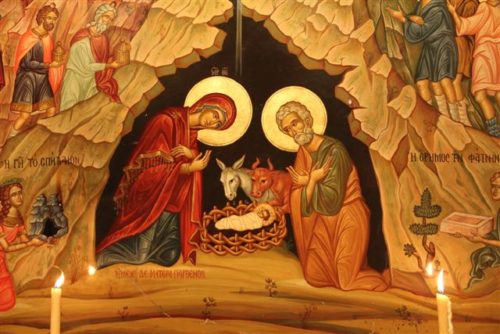
Do I know what the Church is?
This might at first appear to be a foolish questions to ask and I do not ask it lightly. This fundamental question is most appropriate as we prepare to welcome Christ being born in the world. Most adults in the Church are too embarrassed to admit what we don’t understand or what we don’t know. For many of us asking ourselves this question we really must answer, “I don’t truly know what the Church is!” We might answer it is a place I go to pray or a place I go to be with other Orthodox Christians. The basic truth of our faith is that our God is a personal God who humbly came to earth, being born in a manger, so that each of us could enjoy a personal relationship with Him. This is the miracle of Bethlehem. Knowing this, the most basic question we should ask to help answer the question: “What is the Church?” is another question: “Do I have a personal relationship with Jesus Christ?”
Through God’s Holy Spirit, we are no longer lonely individuals. We become personally united with Christ and through Him with each other. The Church transcends time and space. It has cosmic dimensions that connects us with Christ and all our fellow Orthodox Christians. This bond is not limited even by physical death. The Church is Christ and all who are joined with him. This miracle is the mystery of faith. As St. Paul explains in his letter to the Hebrews: “Now faith is the assurance of things hoped for, the conviction of things unseen” (Hebrews 11, 1). We cannot see the Church, yet it is! It is for us the ultimate reality, the Kingdom of God on earth and a foretaste of heaven. This is as personal a relationship as we can experience. This is the answer to the ultimate question that makes the Church a reality in our lives. Once again, St. Paul says it best, “I have been crucified with Christ; it is no longer I who live, but Christ who lives in me; and the life I now live in the flesh I live by faith in the Son of God, who loved me and gave Himself for me.”
After His Crucifixion and Resurrection and Ascension, Our Lord sent His Holy Spirit to empower us; so that we could truly live our life with Him. With our Baptism, we become new creatures in Christ. At our Chrismation, we are given, as a free gift, His Spirit to allow us to grow in Him. By partaking in Holy Communion, we become united to Christ. The added dimension is that we are also united to everyone who participates in His Body and His Blood. The Church is actualized when we, as the faithful, come together and become the Body of Christ. This is the mystery that began in that manger in the cave of Bethlehem. As His Nativity approaches, let us look to Christ to enlighten us to truly be the Church, to have Christ born in our hearts as He was born of the Virgin. Only in this way can we know Him and know within our being that we are the Church.
I pray you all have a blessed Nativity. May Our Lord continue to bless you, your family and all of us. ….Fr G

St. Katherine the Great Martyr
Today when we admire someone who is beautiful, witty and bright we might say, she’s the whole package. This is a perfect description of St. Katherine the Great Martyr. Katherine lived in the early 4th century in the city of Alexandria. Highly educated, beautiful, articulate and of royal blood, Katherine confronted the Emperor Maxentius and professed her faith in Christ. The emperor summoned fifty pagan philosophers to debate Katherine on matters of faith. Catherine(another spelling) refuted their arguments so convincingly that many of her learned opponents accepted Christ. Maxentius was infuriated and ordered Katherine tortured and many of the new converts put to death.
Tortured and imprisoned her courage and deep faith influenced over 200 additional souls to embrace faith in Christ including the emperor’s wife Valeria Maximilla. They too were also martyred. Maxentius tried to entice Katherine by an offer of marriage, but the princes would have none of it. She face even more terrible tortures. The Emperor sentenced Katherine to be tortured on a spoked wheel, which broke in pieces when Katherine touched it. Many icons of the great saint depict her standing next to a wheel. Katherine was finally beheaded at the young age of 18. With her faith and dedication to Christ she earned the grace of the Holy Spirit and the crown of a Great Martyr of the Church. Throughout the centuries many miracles have been accomplished through the intercessions of St. Katherine. She has appeared to many faithful to comfort them in times of distress. The Emperor Justinian named the Monastery on Mt. Sinai in her honour and it is one of the primary pilgrim destinations in the Orthodox world. Holy Martyr of God, Katherine, pray for us.